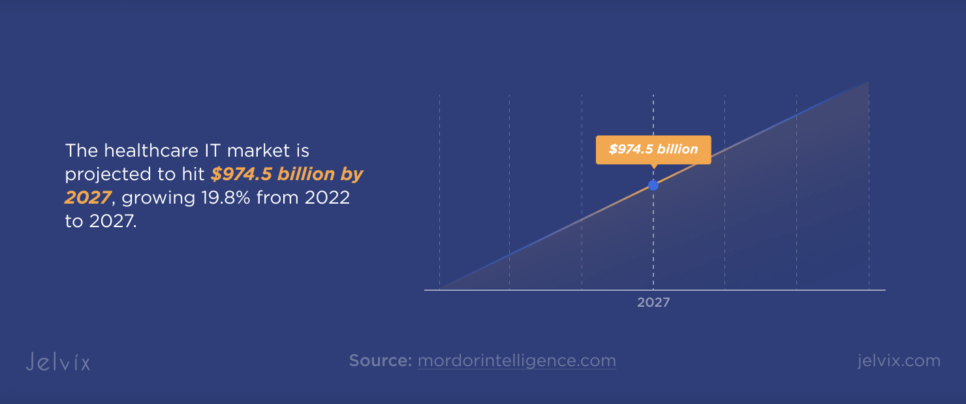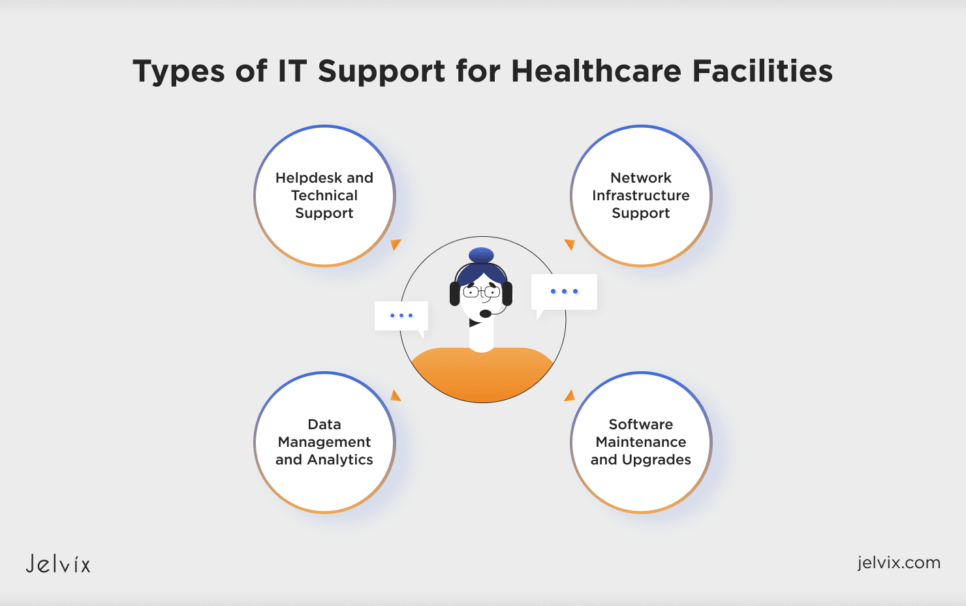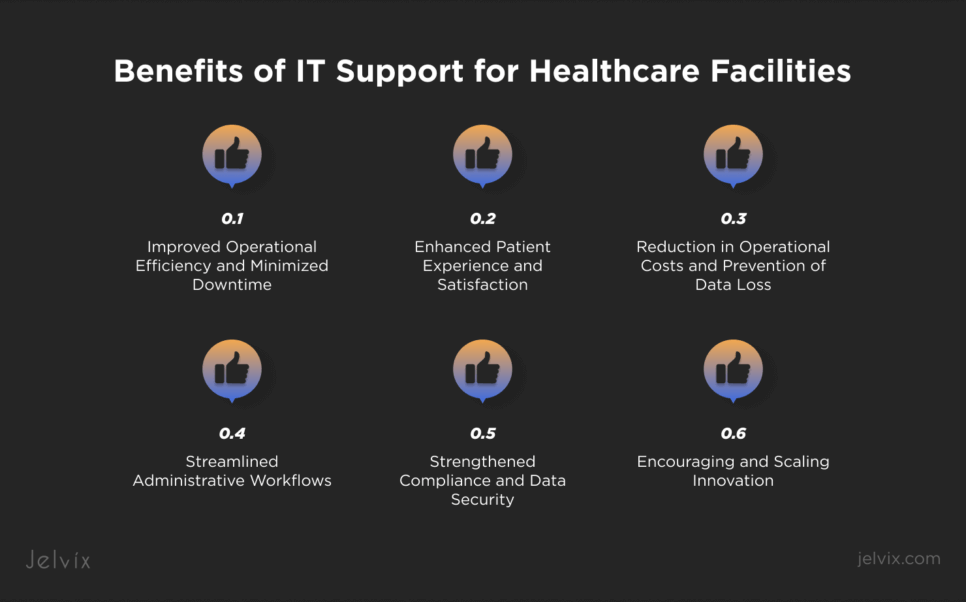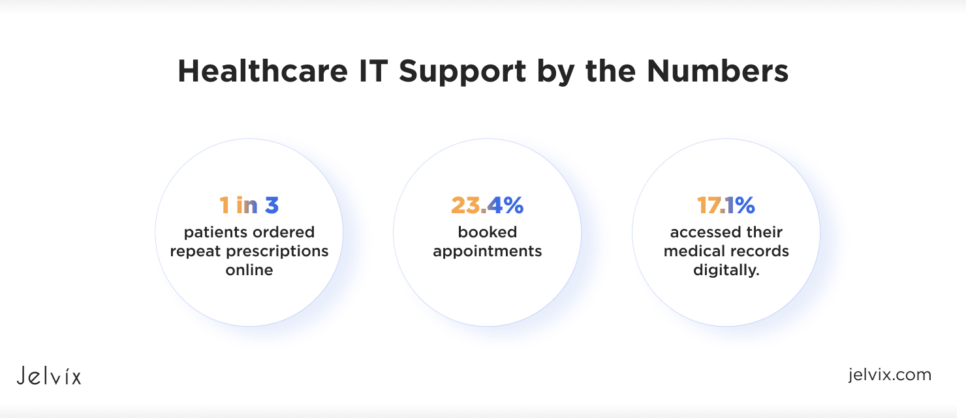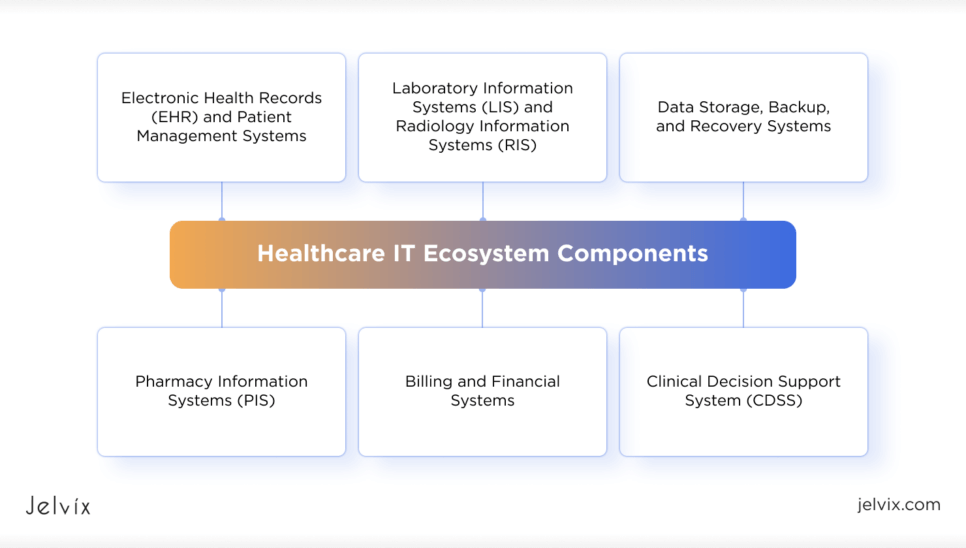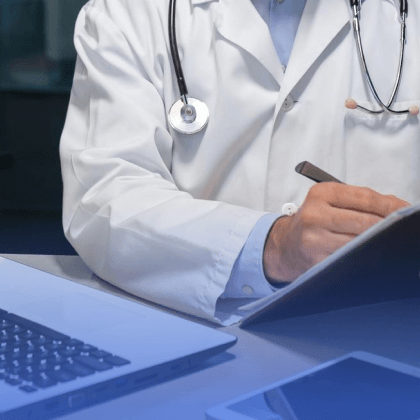IT support is the backbone of many healthcare hospitals, clinics, and medical facilities. Good IT systems are more than just patient databases: they allow fast access to information, enable secure communication between departments, and provide medical teams with the tools needed to deliver faster, improved care. Having dependable IT support allows medical personnel to concentrate on their mission, which is care provision, without interruptions from tech difficulties.
Numerous studies highlight the fundamental role that IT support plays in healthcare. For example, advanced IT systems allow hospitals to have up to 40% fewer administrative errors and 25% more efficient workflows. Moreover, facilities that have simplified IT support experience half the downtimes, leading to unhindered access to patient data for medical staff to make prompt and accurate decisions.
Healthcare IT support services are on the rise. The healthcare IT market is projected to hit $974.5 billion by 2027, growing 19.8% from 2022 to 2027. And it’s no wonder. Healthcare providers believe effective IT support directly impacts patient outcomes. By maintaining secure, accessible, and efficient IT systems, healthcare facilities save valuable time and resources and provide patients with a smoother, more reliable experience. So, let’s explore how exactly IT affects healthcare, and what benefits, challenges, and trends are.
Types of IT Support for Healthcare Facilities
Healthcare facilities depend on IT support services to ensure smooth and secure operations. Let’s explore the main types of healthcare IT support that medical facilities usually rely on:
Helpdesk and Technical Support
Helpdesk support provides an initial point of contact for healthcare personnel to address problems with hardware, software, or medical devices. Streamlined helpdesk services allow for minimal downtime so that nurses, doctors, and administrators can spend their time providing care instead of fiddling with technical issues. The helpdesk is the go-to resource for immediate IT needs, from login issues to troubleshooting equipment.
Network Infrastructure Support
In the medical field, where seamless, secure exchanges between departments are essential, a trustworthy network is needed. Network infrastructure support encompasses everything from Wi-Fi and wired connections to server/network security from potential cyber threats. A strong network infrastructure enables patient records, imaging data, and real-time patient updates to flow freely among authorized users, thus providing the bedrock for any healthcare facility’s communications.
Data Management and Analytics
Every single day, hospitals, clinics, and other medical establishments collect vast amounts of data from a wide variety of information centers – recording patient reports and the mixed reports of clinical trials. Good data management ensures this information is captured, retrieved, and shared safely and efficiently. IT support healthcare teams that focus on data management cover everything from the encryption of patient data to regulatory compliance (HIPAA in the U.S.) to ensure data privacy and security. Additionally, data analytics assist the facilities with sound decisions using the trend over patient care, operational efficiency, and supply chain management.
Software Maintenance and Upgrades
Healthcare facilities deploy specialized software solutions for managing patient records, scheduling, diagnostics, and many other purposes. IT support ensures that this software is often up-to-date, secure, and functional. Regular maintenance and upgrades prevent software vulnerabilities and improve functionality, allowing staff to work with the latest tools. Further, IT teams customize and troubleshoot software, tailoring it to the various departments that use it to maximize user satisfaction and productivity.
When healthcare IT support works efficiently, medical facilities see improvements in workflow, patient safety, and data security. This support optimizes operations across the board, helping reduce errors, streamline administrative tasks, and make vital patient information accessible to healthcare providers. And there are still more benefits of technology in healthcare we can discover.
Benefits of IT Support for Healthcare Facilities
Healthcare facilities rely on effective IT support to maintain smooth operations and enhance patient care. Here’s how IT support brings valuable benefits:
Improved Operational Efficiency and Minimized Downtime
IT in healthcare keeps costly downtimes to a minimum and ensures that tech problems are handled immediately before they become a serious disruption. Well-designed IT systems enable healthcare staff to view patient data, coordinate treatments, and communicate seamlessly. Fewer delays ultimately streamline the work process for IT support and allow healthcare professionals to do what they do best—care for patients.
Enhanced Patient Experience and Satisfaction
Seamless access to patient data and diagnostic tools by healthcare providers enriches patient experience. When these systems work seamlessly, with the help of IT support, interactions become better and as a result trust builds. When providers have immediate and secure access to patients’ records, patients tend to feel more cared for and assured.
Reduction in Operational Costs and Prevention of Data Loss
IT support can prevent healthcare facilities from costly technical issues like data breaches or system failures. By implementing strong data protection measures, facilities can prevent the expensive consequences of data recovery, legal problems, and loss of patient confidence. Moreover, effective IT systems can cut costs by automating everyday tasks decreasing the reliance on manual labor.
Streamlined Administrative Workflows
Healthcare IT support helps automate and optimize administrative duties, including patient record management, appointment scheduling, and billing. IT support helps facilities free up time for healthcare staff, which allows resources to be allocated to patient-facing activities and leads to an efficient and patient-centered approach.
Strengthened Compliance and Data Security
IT support is essential for maintaining compliance with data privacy laws, such as HIPAA in the United States and GDPR in Europe. Through robust systems and routine audits, IT teams enable healthcare institutions to comply with stringent regulatory requirements and safeguard patient information and institutional reputation.
Encouraging and Scaling Innovation
IT support enables healthcare facilities to implement technology confidently when needed and scale up services accordingly. IT support also helps integrate telemedicine platforms, electronic health records, and advanced diagnostic tools, allowing healthcare providers to continue innovating and growing while meeting patient needs.
With proactive medical IT support, healthcare organizations can shift from reactive problem-solving to a proactive strategy that keeps systems secure, staff organized, and patients well-cared about.
Healthcare IT Support by the Numbers: Key Statistics
The importance of IT support for healthcare isn’t just theoretical—numbers clearly show its impact on efficiency, patient satisfaction, and operational improvement. As stated in GP Survey 2023, 1 in 3 patients ordered repeat prescriptions online, 23.4% booked appointments, and 17.1% accessed their medical records digitally. These numbers represent a paradigm shift in how health care is delivered digitally, enabling patients to take control with self-service and relieving a cumbersome volume of administrative duty from staff.
Hospital IT support systems can also undertake triage and redirect patients to other facilities, resulting in better resource management only around 73% of A&E patients were seen within four hours in June 2023. Emergency departments came under extreme pressure, with 2.1 million A&E visits and 545,000 emergency admissions in November 2023.
If you feel alone while you are in treatment, it can also affect your recovery. Fortunately, only 8.7% of patients felt isolated in the past year, which meant a 3.5% decrease from 2022. The drop illustrates the value of the IT-enabled connection in enhancing the patient experience and reducing hospital readmissions by helping patients stay connected with their support networks.
Further, most people try to Google their symptoms to learn more about their prescriptions or diagnoses. The GP Survey 2023 found that three in five patients visited their GP’s website for information, an increase since 2022. This minor but consistent rise reflects a trend towards online resources that only require patients to access the necessary information and services without needing a phone call or in-person visit.
This data illustrates the impact of IT support on creating a more effective and patient-focused healthcare system. Healthcare IT is making great progress in enhancing accessibility, decreasing wait times, and enabling patients.
Latest Trends in Healthcare IT Support for 2024
This year’s trends have all been about using technology effectively to streamline processes, improve accessibility, and actively support healthcare providers in providing better care through solid IT infrastructures. First, Artificial Intelligence (AI) and Machine Learning (ML) revolutionize healthcare diagnostics and workflow management.
These technologies can analyze medical images and huge datasets of patient information to highlight patterns that could elude the human eye, thus allowing physicians to diagnose illnesses more quickly and accurately. Moreover, by automating mundane administrative tasks, AI and ML enable healthcare professionals to spend more time caring for patients.
At the same time, cloud-based solutions are allowing healthcare providers to move to more of a centralized data access model, with patient information being installed and stored in the cloud. This also enables authorized medical personnel to access real-time medical records from any place via the Internet, thus ensuring the smooth scaling of hospitals, clinics, and other health services. Having centralized access to data enables the healthcare teams to make better decisions, deliver timely treatments, and ensure that patient details are always accurate and available
As medical IT services continue to transform patient care, telemedicine support and digital health innovations are taking center stage. Telemedicine allows patients to see a doctor from the comfort of their homes, benefiting people, particularly in rural or remote areas. Digital health tools (e.g., mobile health apps) allow patients to monitor their health and communicate with healthcare providers more quickly, increasing health options closer to the patient and improving the relationship between patients and healthcare providers.
The interoperability of healthcare systems—ensuring that various software and systems can efficiently connect with one another—is becoming increasingly important. This link is essential because it allows medical staff to share patient data easily, enhancing care coordination, efficiency, and efficacy. Effective collaboration among hospitals, clinics, and experts can facilitate the execution of patient care plans, lowering the possibility of errors or delays.
Compliance with Medical Regulations: Ensuring Standards in Healthcare IT Support
Patient care is at the center, and advisors cannot risk an inaccurate diagnosis. Strict regulations protect patient data in managed IT services for healthcare. Key frameworks include HIPAA (in the U.S.), which safeguards patient privacy and data security, and GDPR (in the EU), which controls how personal data is managed. These regulations establish protection standards for patient information, which must be handled at the highest level of security.
Compliance is essential for maintaining patient confidence and avoiding fines. By adhering to these guidelines, medical facilities show their dedication to data security and privacy, which is crucial for gaining patients’ trust.
IT support plays a vital role in helping facilities meet these regulatory requirements. IT teams employ security techniques to keep systems secure, compliant, and current with the most recent requirements, including encryption, access limits, and frequent audits. IT support is a backbone, allowing healthcare professionals to concentrate on patient care while maintaining data security and compliance.
Healthcare IT Ecosystem Components
IT services in the healthcare industry ecosystem comprise various systems supporting efficient, secure, and adequate medical care. They include:
- Electronic Health Records (EHR) and Patient Management Systems. EHR stands for electronic health records, which are digital versions of the paper charts in the clinician’s office. These records consist of patient history, treatment plans, and notes from different doctors, helping providers coordinate care. Patient management systems, however, are geared toward scheduling, tracking appointments, and managing patient interaction.
- Laboratory Information Systems (LIS) and Radiology Information Systems (RIS) are specialized systems that manage data related to lab tests and radiology services. With an LIS, labs can manage the complete lifecycle of their sample tracking, test results, and reporting, whereas an RIS organizes imaging requests, results, and image storage.
- Billing and Financial Systems. These systems manage all billing, invoicing, and payment processes in healthcare facilities. These services manage insurance claims, patient billing, and payment tracking, allowing the healthcare organization to receive the right payment on time. Good billing processes decrease administrative burden, enhance accuracy, and improve financial stability.
- Data Storage, Backup, and Recovery Systems. Data storage and data backup systems are imperative for maintaining patient records and other sensitive data. Backup and recovery systems protect data in case of accidental or intentional destruction. This component safeguards the continuity of operations and protects patient privacy by ensuring data integrity and availability.
- Pharmacy Information Systems (PIS). From prescription orders to inventory control, PIS manages anything related to medication. Adopting these systems plays a vital role in enabling confirmations of accurate dispensing, tracking medication usage, and minimizing chances for any potential drug interaction, eventually leading to improved pharmacy operational safety and efficiency.
- Clinical Decision Support System (CDSS). CDSS will give medical professionals in the field data-driven knowledge and recommendations for making clinical decisions more efficiently. CDSS helps providers make informed choices and improve diagnostic accuracy and patient outcomes by analyzing patient data and applying evidence-based guidelines.
These elements form a complete healthcare IT ecosystem that enhances processes, promotes patient care, and guarantees data security throughout healthcare facilities.
Cybersecurity in Healthcare IT Support: Protecting Patient Data
Cybersecurity is critical in any industry, but especially in healthcare, where the confidentiality of patient data is paramount. Personal and medical information found on patient records is potential ammo for identity theft, fraud, or privacy violations. Naturally, IT support for clinics prioritizes protecting such data.
From ransomware attacks to phishing scams and unauthorized access, healthcare facilities face several types of cyber threats. These attacks exploit system vulnerabilities, such as outdated software or weak passwords, to access sensitive information.
To combat these threats, IT support teams implement several key measures:
- Data Encryption: Converts data into secure code, ensuring only authorized personnel can read it.
- Firewalls and Access Controls: Block unauthorized access and allow only verified users to access patient data.
- Employee Training: Educates staff on recognizing phishing and other scams, as human error often opens doors to cyberattacks.
Through these proactive steps, support services in healthcare strengthen data security, helping to protect patient information and maintain trust in healthcare services.
Technologies for Healthcare IT Support
Effective IT support for medical practices relies on a suite of technologies that keep medical systems secure, responsive, and efficient.
Remote Monitoring and Management Tools
Remote monitoring lets IT teams view system performance from anywhere to resolve issues before they disrupt healthcare services proactively. By providing ongoing monitoring, potential interruptions can be mitigated, thereby maintaining critical health services available and operational.
Cloud-Based Solutions and Hybrid Infrastructures
Cloud solutions offer flexible and secure storage while minimizing space concerns—making it easier for healthcare providers to retrieve patient information from multiple locations. Hybrid infrastructures, which combine on-premise and cloud storage, offer flexibility by keeping sensitive data on-site while using the cloud for non-critical functions. This balance is important for healthcare facilities to have both accessibility and a strong security posture.
IT Automation for Issue Resolution
Automation tools can execute certain support tasks automatically − such as resetting passwords or performing updates − without human involvement. Automating these processes enables healthcare IT teams to respond quickly to common issues while creating more time for complex support needs.
Data Analytics and Business Intelligence (BI) Platforms
In the healthcare space, data analytics and BI platforms leverage access to large sets of information that drive decision-making. They assist in analyzing statistical trends relating to patient care, tracking operational efficiency, and identifying opportunities for improvement. Data analytics and BI allow healthcare organizations to obtain data-informed decisions with much better patient outcomes, more refined workflows, and optimized resources.
Together, these technologies support healthcare IT operations, guaranteeing that healthcare facilities have safe, effective, and dependable systems that improve patient care and expedite facility operations.
The Smart Way to Choose – Download Your Guide to Selecting the Right Healthcare Tech Partner!

Rapid Response to Technical Issues: Minimizing Downtime in Healthcare
In healthcare, rapid response to technical issues is critical. Medical facilities rely on uninterrupted IT systems to access patient records, communicate with other departments, and manage equipment. Even a small downtime can affect patient care, cause complications in treatment plans, and reduce the facility’s overall efficiency. This is why healthcare IT support teams focus on quick technical responses to the issue to reduce downtime and assure uninterrupted and quality patient care.
A swift response can be a significant game-changer when technical hiccups come up. For example, having an electronic health record (EHR) system go down may mean a clinician does not have immediate access to key patient data, such as a history of allergies, delaying diagnosis or treatment. When a problem does occur, however, an IT team specializing in quick response can get to the site immediately and determine the fix needed to bring the system back online and minimize the effect on patient care.
On the other hand, consider an outage of a telemedicine platform used by a hospital. Patients in far-off areas who depend on virtual appointments must avoid service disruptions to ensure they get proper treatment or care plans for their conditions. This is where quick actions of an IT support team can restore the telemedicine platform in no time, enabling the health provider to perform remote consultations instantly without any major disruptions.
These examples highlight why rapid response to IT issues is essential in healthcare. By quickly addressing problems, IT support teams maintain operational continuity, improve patient outcomes, and preserve trust in healthcare services.
Discover how we developed a personalized EHR system that optimized the clinic’s workflow while ensuring maximum privacy and security.
Software Support and Maintenance Setup Plan
Setting up a practical software support and maintenance plan is vital for healthcare IT systems, as it ensures reliability, security, and continuous operation. First of all, it has to meet the main requirements, which might include the following:
- regular software updates for security;
- data backup and recovery processes;
- compliance with healthcare regulations (like HIPAA);
- troubleshooting support;
- access to system performance monitoring.
Moving further, nothing works out without a plan. A clear support process strategy is essential. This strategy should define the workflows for troubleshooting, updates, and system maintenance. It should include:
- escalation protocols for critical issues;
- standard response times;
- communication channels between IT teams and healthcare staff;
- procedures for monitoring system health.
Continuing with maintenance, different software maintenance models are suited to various needs in healthcare:
- Corrective Maintenance: Focuses on identifying and fixing software issues or bugs as they arise. This model is essential for promptly resolving unexpected problems.
- Preventive Maintenance: A proactive approach that includes regular updates, security patches, and performance optimization. Preventive maintenance helps prevent issues from occurring in the first place.
- Adaptive Maintenance: This involves modifying software to work with new technologies or regulatory changes. This can mean adapting to new compliance rules or integrating new medical devices in healthcare.
- Perfective Maintenance: Focuses on refining and improving the software to enhance its performance and usability. This can involve adding features supporting healthcare workflows or improving the user interface so staff can use it more easily.
Finally, to ensure excellent results, all sides should:
- Ensure that IT teams stay up-to-date with healthcare regulations and new technology trends.
- Maintain thorough records of all maintenance activities, troubleshooting steps, and software updates to help with future issues and audits.
- Use monitoring tools to monitor system performance. These tools provide automated alerts for potential issues, allowing for quick intervention.
- Build strong communication lines with healthcare providers to ensure they understand the support process and how to report issues.
- Track metrics such as response time, downtime, and system uptime to assess the effectiveness of support and maintenance efforts.
Conclusion
Effective IT support plays an essential role in enabling modern healthcare to meet today’s demands—from rapid response to technical issues to maintaining strict regulatory standards and supporting patient-centered healthcare facilities.
Partnering with Jelvix means gaining access to expert IT support tailored to the unique needs of healthcare providers. Our team brings deep experience in healthcare IT, offering solutions that prioritize security, reliability, and regulatory compliance. Jelvix ensures that your IT infrastructure is in safe hands, so you can concentrate on what matters—providing unparalleled care for your patients.
FAQ
Is it safe to outsource healthcare IT support, or does it compromise data security?
Yes, outsourcing can be safe. Reputable IT providers use strict security measures, such as 24/7 monitoring, encryption, and access controls, to protect against unauthorized access and cyber threats and ensure data security.
What training or onboarding is provided by IT support teams for healthcare staff?
IT support providers typically offer training on cybersecurity, EHR management, and troubleshooting to help healthcare staff effectively use new systems, ensuring they feel confident and skilled.
What role does IT support play in managing healthcare data analytics?
IT support helps maintain and optimize data analytics tools, ensuring smooth integration with other systems and protecting data privacy. This enables facilities to make informed, data-driven decisions.
Can we modify our IT support agreement as our healthcare organization grows or changes?
Yes, IT support agreements can be adjusted as needs change. A good IT partner allows flexible terms to accommodate growth, new technology, or evolving business goals.
How can healthcare IT support help with the integration of legacy systems?
IT support can bridge legacy systems with modern infrastructure, ensuring compatibility and data flow while allowing facilities to modernize without operational disruptions gradually.
Need high-quality professionals?
Unlock new business opportunities with the first-rate dedicated development team.


